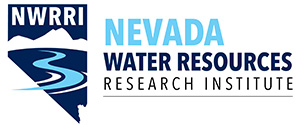Nevada Water Resources Research Institute
NWRRI Funded Projects
The following ventures are the most recently funded projects by NWRRI. This work is supported by the U.S. Geological Survey under Grant/Cooperative Agreement No. G21AP10578.
Recently Funded Projects
display: none
Your content goes here. Edit or remove this text inline or in the module Content settings. You can also style every aspect of this content in the module Design settings and even apply custom CSS to this text in the module Advanced settings.
Development and Enhancement of OpenET Software Tools, Datasets, and Planning
Abstract
The goal of the project is to research and enhance evapotranspiration (ET) mapping and modeling capabilities for national-scale consumptive water use estimation and reporting and collaborate with the U.S. Geological Survey (USGS) and the OpenET consortium. Activities are focused on research, development, and enhancement of (1) CONUS404 gridded weather data assessments and OpenET integration; (2) flux data processing and intercomparison tools through development and documentation of end-to-end software workflows; (3) implementation of uncertainty and quality assurance maps within OpenET; (4) intercomparison of commonly used irrigated area datasets and assessment of resulting differences in ET volumes from irrigated lands; (5) use of Python open-source notebooks to easily reduce and summarize OpenET raster data through development, documentation, and training; 6) open water evaporation estimation software workflows through development, documentation, and public outreach and engagement; and 7) assessment of Vegetation ET (VegET) effective precipitation (PPT) products. DRI will collaborate with USGS, the OpenET consortium, and the public to research and advance ET mapping capabilities. The intended beneficiaries of this project are state and local water agencies, agricultural producers, and the public. The quantification of ET is necessary for irrigation water management, estimating past and future streamflow depletions stemming from irrigation activities, basin-wide water balance estimates, and consumptive water use reporting.
Flooding Frequency and Severity across the Wildfire Continuum throughout the Western United States
Abstract
Moderate- to high-severity wildfire can abruptly alter watershed properties, which intensifies extreme hydrologic responses such as debris flow and flooding. Understanding the frequency and severity of such compound wildfire-flood hazards is of growing importance, particularly in wildfire-prone regions. However, standard statistical flood frequency analysis approaches are ill-suited to examining this issue because wildfire-affected peak flow observations are limited in number and violate the assumption of independent and identically distributed events. This study aims to develop a process-based flood frequency analysis framework that integrates stochastic storm transposition, a wildfire emulator, dynamic hydrologic parameterizations, a physics-based hydrologic model, and CONUS404 forcings to simulate the impacts of wildfire on flood frequencies. We will apply this framework to five wildfire-prone regions across the western United States to quantify the role of wildfire in shaping flood frequency at scales ranging from a hillslope (≤1 km2) to a watershed size of >5,000 km2. Additionally, the realistic simulation with a large sample size can help better understand the interplay between high-intensity rainfall and wildfire in driving flood frequency distributions across various regions in the western United States. This study will advance post-wildfire hydrologic modeling and the next generation of flood frequency standards. To broaden the impact of our work, we will host a training workshop for water experts from local and federal agencies, develop two ArcGIS StoryMaps to share the research findings with the public, and provide training to K-12 educators and graduate students. This study will further promote collaborations between researchers in academia and scientists at the U.S. Geological Survey.
Comparative Analysis of Climate Driven Shifts in Streamflow Trends for the Upper Carson and Walker River Basins
Abstract
Climate change poses significant challenges to water resource management in snowmelt-dominated regions of the western United States. This study addresses the problem of shifting streamflow timing and magnitude in response to warming temperatures in the Carson and Walker River Basins. Although a shift toward earlier streamflow is documented in the western United States, streamflow changes and impacts at the watershed scale remain poorly understood. The primary objective of the proposed study is to analyze historical streamflow trends in the headwaters of both basins to assess whether the timing and magnitude of streamflow changes is consistent along the Sierra Nevada’s eastern slope. A secondary objective is to identify watershed-specific factors influencing streamflow trends in each basin. Utilizing observational streamflow and climate data from publicly available databases, the study seeks to isolate the effects of warming temperature on streamflow, focusing on upper watershed areas as they are minimally impacted by human activities. Statistical analyses, such as correlation dimension and multiple linear regression, will be employed to examine the linkages between time series of streamflow, temperature, precipitation, and snow-water-equivalent and the interdependencies between these hydrometeorological variables and watershed characteristics. The expected benefits include informing adaptive strategies for water managers and policymakers and aiding agricultural stakeholders in mitigating risks associated with earlier snowmelt. Additionally, the study aims to train an undergraduate student in research methodologies and foster collaboration with water management agencies and stakeholders. Ultimately, the research aims to provide actionable data to support informed decision-making and enhance resilience to climate impacts in snowmelt-dominated regions.
Removal of Fluoride from Groundwater in Rural Communities of Nevada
Abstract
The Beatty Water and Sanitation District reported local groundwater sources with fluoride concentrations four times the EPA guidelines, generating concern for local water authorities. Long-term exposure to fluoride concentrations higher than 1.5 mg/L have negative health impacts on water users. Water defluoridation is complex in rural communities without access to a central public water system or the resources and technical support for water treatment. This project aims to assess the feasibility of scaling up electrocoagulation (EC) technology developed in the past by DRI to reduce fluoride concentration in groundwater using Beatty, Nevada, as a pilot case. The detailed objectives of this proposal are to: (i) identify the effects of initial fluoride concentrations using real groundwater from Beatty, Nevada; (ii) assess the power consumption/requirements of the technology; (iii) investigate routine operation/maintenance requirements and the effect of competing ions; and (iv) characterize by-products.
This project will be completed through the collaboration of two groups at DRI, the Center for International Water and Sustainability (CIWAS) and the Environmental Engineering Laboratory (EEL), and the Beatty Water and Sanitation District (BWSD). AutoCAD will be used to develop the EC prototype based on lab-scale results from previous research. The key parameters that will be considered are: (i) electrode surface area to reactor volume ratio, (ii) current density, and iii) electrode separation. The experimental design will include assessing the effect of parameters such as: (i) initial fluoride concentration; (ii) the presence of competing ions; and (iii) the addition of Moringa oleifera extract. EC prototype testing experiments will be conducted for four weeks with performance data collected every other day in collaboration with BWSD. The sludge/foam by-products generated will be removed at the end of every trial, dried, weighed, and characterized to quantify the amount of waste produced.
A Storyline Approach to Assess the 1997 New Year’s Flood in Western Nevada
Abstract
Western Nevada is vulnerable to extreme winter storms and subsequent floods. Climate change, population growth, and urbanization will exacerbate the impacts of future flood events. More robust methodologies to better understand the future flood events, especially for the extreme ones, are needed. The traditional approach relies on ensembles of climate model simulations, statistical bias correction, downscaling to the local scale, and then to fit the generalized extreme value distribution to derive the quantiles of different recurrence intervals (e.g., 100-year rainfall). Such an approach provides a limited physical understanding of future extreme events, and its veracity cannot be tested. Alternatively, the numerical weather predication model combined with a hydrological model in a hypothetical climate setting can provide narratives of simulations of a historical high-impact event in a future climate. This event-based dynamic modeling approach is referred to as a “storyline.” In this study, we will use a storyline approach to assess the 1997 New Year’s Flood in western Nevada. We will deconstruct this extreme event to its physical driving factors, and then simulate how these factors interact with an altered future climate in driving future hypothetical floods. We will integrate a global climate model simulation with a regional-scale weather model and local-scale hydrological model. This proposed work will potentially provide complementary and more realistic and physically consistent pictures of what the 1997 New Year’s Flood might look like 100 years later.
Applying Instrumental Neutron Activation Analysis (INAA) to Study the Concentration Variation of Heavy Metals in Lake Mead due to Climate Change and Population Growth in Southern Nevada
Abstract
Water resources and their quality are critical to human life and the ecological system. In southern Nevada, nearly 90% of water comes from nearby Lake Mead. In the recent decade, climate change and population growth have altered water chemistry in Lake Mead, and concentrations of heavy metals conceivably increase as the water level recedes due to megadrought. Traditional water monitoring only focuses on a few heavy metals, such as mercury and lead. However, the accumulative effects of other heavy metals cannot be simply ignored, especially as Lake Mead moves toward the direction of a “dead pool.” The accumulative effects of heavy metals can damage the cognitive capacity of young people at an early stage.
To resolve this looming challenge, we propose studying the heavy metals in the water of Lake Mead with the most sensitive multielement radioanalytical technique, Instrumental Neutron Activation Analysis (INAA). After irradiating the samples with thermal neutrons, qualitative and quantitative information about elements can be obtained from the decay spectra recorded by gamma-ray spectrometers. The objectives of the study are to:
(1) Apply INAA to identify heavy metals in Lake Mead and calculate their concentrations up to the parts per billion level.
(2) Investigate the seasonal variation of heavy metal concentrations in Lake Mead and establish the baseline values in various seasons.
(3) Investigate the relationship of isotopes in groundwater downgradient from the Nevada National Security Site to ensure there is no contamination entering Lake Mead.
The data collected will be a guide and future reference for water pollution and environment monitoring for Lake Mead. The results will educate the public about the environmental impact of climate change and human behavior on water quality. Pertinent information will be disseminated to residents via publication.
NWRRI Undergraduate Internship Immersion Program
Abstract
According to the Water Resources Research Act of 1984 (as amended) that created the National Institutes for Water Resources (NIWR), each institute is to arrange for research that fosters the training and education of future water scientists, engineers, and technicians. The goal of the Undergraduate Internship Immersion Program is to attract additional students who may not have considered a water-related STEM career. The program will expose college undergraduates to water-related issues and water-related sciences during their postsecondary education, a time when numerous career options remain in play. The interns will gain direct exposure to active research in water-related earth sciences. Exposure of this kind will increase the skill set of the undergraduate students and the possibility that they may pursue careers in earth sciences. The program will pair undergraduate students from Nevada community and state colleges with DRI scientists for a semester-long paid internship. These students will increase their skill sets and be exposed to a variety of career options that might have not been apparent to them prior to their involvement in this program.

CONTACT
Dr. Sean McKenna
Director
Sean.McKenna@www-dev.dri.edu
775.673.7305
Matt Bromley
Deputy Director
Matt.Bromley@www-dev.dri.edu
775.673.7944
Suzanne Hudson
Program Administrator
702.862.5464
Suzanne.Hudson@www-dev.dri.edu
LOCATION
Desert Research Institute
755 East Flamingo Road
Las Vegas, NV 89119
DIVISION
Hydrologic Sciences
